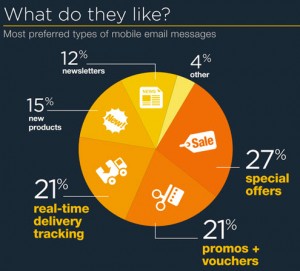Last week blog looked at how mobile advices are changing email marketing. It was established that mobile advice has become central in consumers’ life and generating results. But with consumers been target with hundreds of promotional e-mails and newsletters, how can e-marketers let their promotional e-mails and newsletters stand out and most importantly influence consumers’ decision making.
To understand the power of email, it is imperative to examine the communication process, which comprises four elements: sender, receiver, medium and feedback process. This blog will focus on the receiver (consumer). First of all we need to identify what types of e-mails consumers prefer. According Edialog (2011) research, 27% of the respondents preferred emails with special offers followed by vouchers (21%) and real-time tracking (21%).
With all these different types of emails preferred by consumers, the most important question is how can e-marketer make his email on mobile stand out? For me, Personalised emails always gets my attention. As an active online shopper am always targeted with hundreds of promotional emails and most of the time I delete it to make sure I don’t miss important emails. But personalised emails make me pay greater attention to messages or promotions because it makes me believe it relates to my interests.
Personalisation of email doesn’t only help get consumers’ attention but helps build a good relationship between the businesses and consumers (Huang and Shyu, 2009). I remember when I got my first smartphone around 2008 and connected my email to it. A few minutes later I got an e-mail from Blackberry with my name on it, thanking for choosing Blackberry. I felt so special, this made produce my own positive mental picture of Blackberry and anytime I had a problem I never hesitated to email them. That is the power of Personalisation of email.
The attributes and qualities associated with Personalisation of emails are very powerful e-marketers can use it to their advantage. Chatterjee and McGinnis (2010) said that consumers’ perception of fairness increase when they are the recipient of personalised promotion or offer, because they see it as e-retailer willingness to scarify profit in other to build a strong relationship with them and this make them responds positively.
As consumers we are always looking for value for money and see ourselves as competent shopper. There is a strong believe that personalised email with promotion offers may lead to consumers perceiving themselves as competent shopper as they believe they are paying “special” lower price.
- Trust Issue?
Yes, we all know there is always trust issue when it comes to shopping online. With the increase identity and credit card fraud consumers are always careful who they give their details to. Therefore, as a consumer if I receive a personalised email from a business without me giving them my details I will be very reluctant to purchase from them. With personalised emails some consumers may feel “being singled out” and see it as attempts to influence them leading to perceptions of unfairness (Friestad and Wright 1994).
- If you going to use it use it properly
I am a strong advocate personalisation as a form of trust and professionalism, therefore is it very important to get my name right. Must individuals like me have a pet hate for misspelt name. It shows lack of attention to detail and effort.
In personalised emails, the contents have to be engaging and personal. In most personalised emails the only personalised part is the name, the content reads out like the e-marketer is talking to the rest of the world. This is not right!! The whole e-mail from the heading to conclusion has to be about the subjected consumers only.
- How to get to know consumers better
To avoid these mistakes and employ personalised email strategy effectively, you need to know your consumers better. When a consumer visits your website and signs up, this presents an opportunity to get to know them. It is advisable for retailers to consider a box next to First/ Last Name of ‘How would you like us to refer to you?’ this can help you to refer to the consumer properly in the future.
The same goes for “what would you be most interested know more about?” this helps you to generate the right content for each consumer. To help your strategy stands out better, you could ask for date of birth and “how often would you like use to contact?” This will give an idea how often to email your consumer. On the consumer’s birthday, you can send a special email with personalised offer to wish them happy birthday.
Reference
e-dialog, (2011). Email Relevance and the Proliferation of Mobile Email Use. 1st ed. e-dialog. Available: < http://www.e-dialog.com/pdf/whitepapers/ED321_EMEA_Email_Attitudes_Mobile.pdf> (Accessed 28 Apr. 2015)
Chatterjee, P. and McGinnis, J. (2010). Customized Online Promotions: “Moderating Effect Of Promotion Type On Deal Value, Perceived Fairness, And Purchase Intent”. The Journal of Applied Business Research, [online] 26(1), pp.13-18. Available: <http://file:///C:/Users/owura/Downloads/302-1175-1-PB%20(1).pdf> (Accessed 28 Apr. 2015).
Friestad, M., & Wright, P (1994), “The persuasion knowledge model: How people cope with persuasion attempts,” Journal of Consumer Research, 21, 1–31.
Huang, J. and Shyu, S. (2009). Building personalised relationships with customers via emails.Total Quality Management & Business Excellence, 20(6), pp.585-601.

